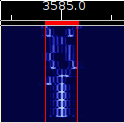
Throb-1
Spectrum
Sound
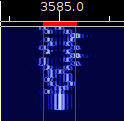
Throb-2
Spectrum
Sound
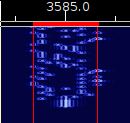
Throb-4
Spectrum
Sound
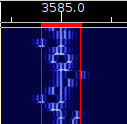
Throb-1X
Spectrum
Sound
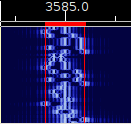
Throb-2X
Spectrum
Sound
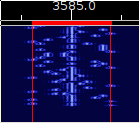
Throb-4X
Spectrum
Sound

Throb-1 Spectrum Sound |

Throb-2 Spectrum Sound |

Throb-4 Spectrum Sound |

Throb-1X Spectrum Sound |

Throb-2X Spectrum Sound |

Throb-4X Spectrum Sound |
The mode has no Forward Error Correction, is difficult to tune, but reasonably sensitive and moderately robust. Because of the limited character set however, the typing speed is reasonably good, one character per symbol. Tuning must be very accurate, and the software will not tolerate differences between transmit and receive frequency. THROB is essentially a curiosity mode.
Another unusual feature (which led to the name), THROB also includes raised cosine AM modulation of each symbol. This combined with two tones transmitted at the same time, means that a very linear transmitter is required.
For THROB, nine tones are used, spaced 8 or 16 Hz. For THROBX, 11 tones are used, spaced 7.8125 or 15.625 Hz. The THROB family was developed by Lionel G3PPT.
Reception is non-coherent, and sync is recovered from the amplitude modulation.
| Mode | Symbol Rate | Typing Speed1 | Duty Cycle2 | Modulation | Bandwidth3 | ITU Designation4 |
| THROB1 | 1.0 baud | 1.0 cps (10 wpm) | 80% | 1/2 of 9-FSK | 72 Hz | 72H0F1B |
| THROB25 | 2.0 baud | 2.0 cps (20 wpm) | 80% | 1/2 of 9-FSK | 72 Hz | 72H0F1B |
| THROB4 | 4.0 baud | 4.0 cps (40 wpm) | 80% | 1/2 of 9-FSK | 144 Hz | 144HF1B |
| THROBX1 | 1.0 baud | 1.0 cps (10 wpm) | 80% | 2 of 11-FSK | 94 Hz | 94H0F1B |
| THROBX2 | 2.0 baud | 2.0 cps (20 wpm) | 80% | 2 of 11-FSK | 94 Hz | 94H0F1B |
| THROBX4 | 4.0 baud | 4.0 cps (40 wpm) | 80% | 2 of 11-FSK | 188 Hz | 188HF1B |
1. WPM is based on an average 5 characters per word, plus word
space. Values are approximate because a variable length code is
used.
2. Transmitter average power output relative to a constant carrier
of the same PEP value.
3. This is the "Necessary Bandwidth" as defined by the ITU.
4. A summary of the ITU Designation system can be found at